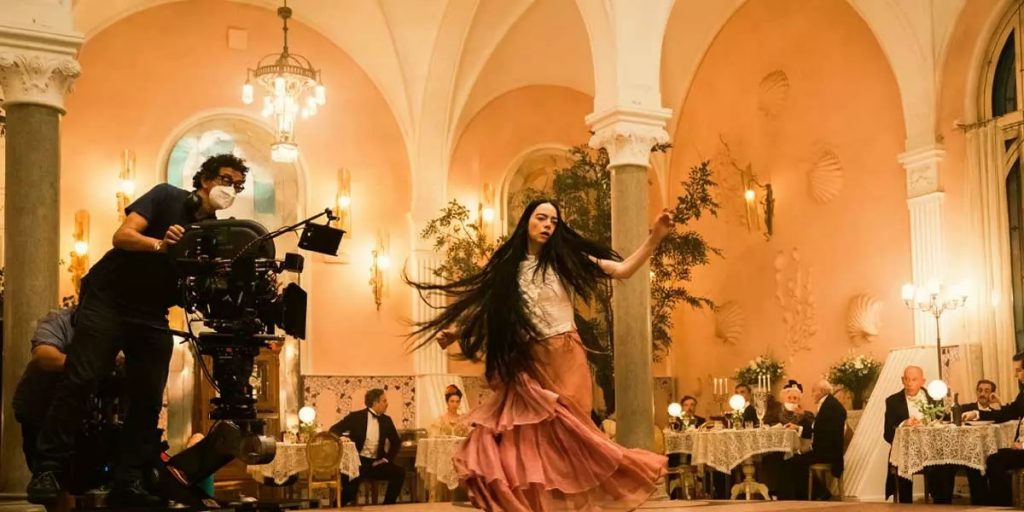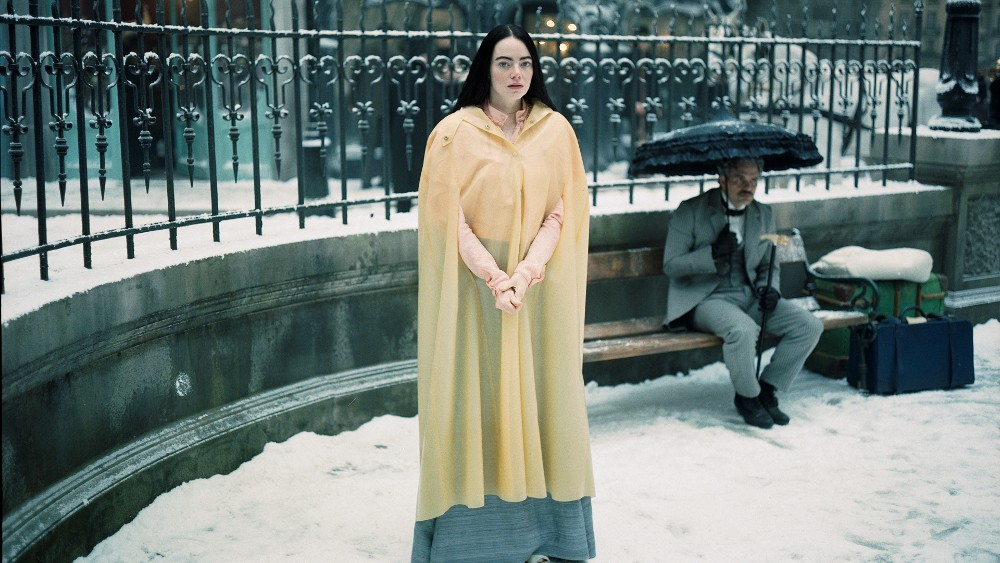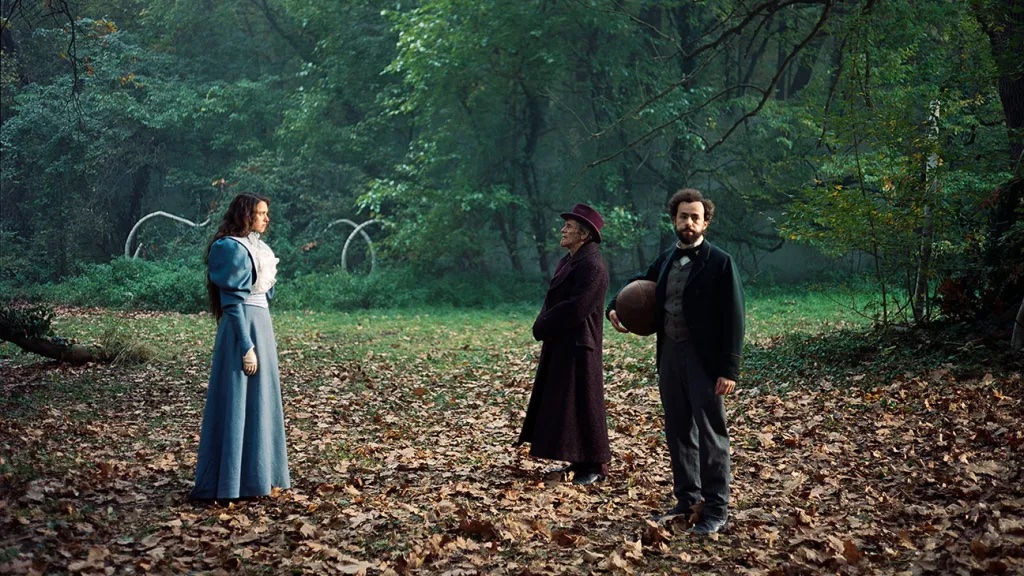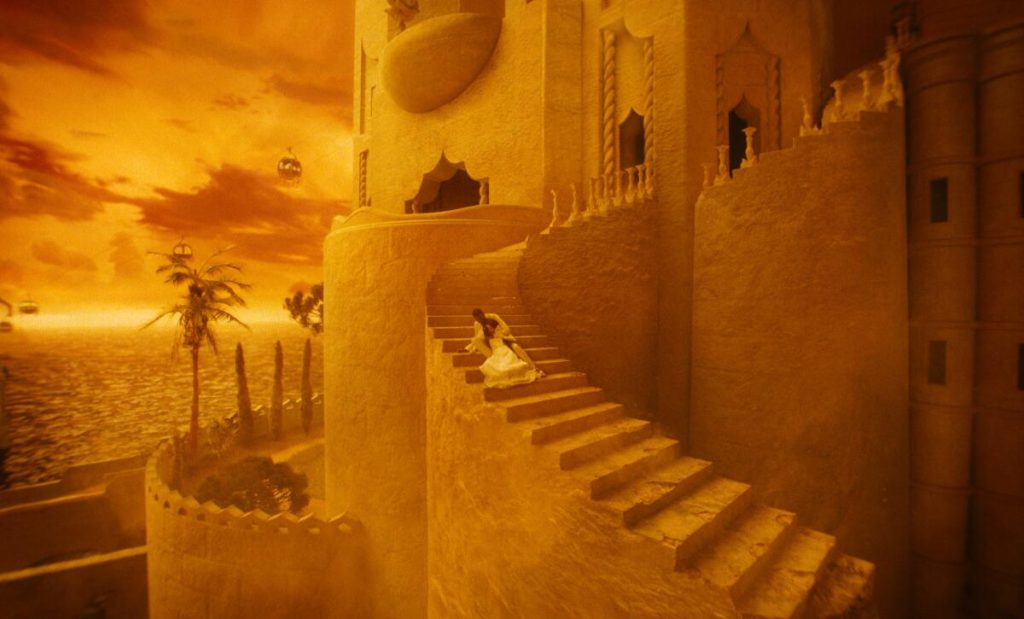
You’ve got to admire a cinematographer who knows how to sell. Cinematographer Robbie Ryan is an exceptional promoter of his most recent collaboration with Yorgos Lanthimos, the spellbinding Poor Things. As Ryan says with a chuckle, see this original vision twice on the big screen to attempt to soak in all the details on display as Bella (Emma Stone) experiences the world through fresh, sometimes candy-colored eyes.
Over the last few years, Ryan has been a frequent collaborator with filmmakers such as Andrea Arnold (Fish Tank) and Noah Baumbach (Marriage Story). Together, Yorgos and Ryan are peanut butter and jelly on the big screen, a collision of taste that produces otherworldly sights.
Recently, Robbie spoke with Below the Line about Poor Things, and clearly, he’s as big of a fan of the movie as audiences and critics are.
Below the Line: Did you and Yorgos talk about James Whales’ movies?
Robbie Ryan: I’m a massive fan and we looked at Bride of Frankenstein for the reanimation scene, because it’s done so well in that film. They got to use real sparks, but we weren’t allowed. We were told, “No, no, you can’t use those.” So yeah, his cinema is definitely one of the ones that was on the list. I’m a massive fan of James Whale. I think he’s somebody who landed from another planet in the films he was making.
BTL: One of my favorite interpretations of this movie is that God (Willem Dafoe) is Dr. Frankenstein’s monster years later.
Robbie: That’s true. Because yeah, Frankenstein landed, he became so intelligent, and he probably would’ve become a doctor.
BTL: This movie is, of course, beautiful. How’d you land on the four or five lenses you and Yorgos used to create this vision?
Ryan: Well, we did a lot of testing and we fine tuned it down to the ones that were suitable for what we wanted. Yorgos wanted to use a Master Zoom on this one, so he was trying to get an impossible zoom, which would go from very wide to very tight, but we could only kind of find when it went from not so very wide to tight enough. And that was a 16.5 to 110, and that was our workhorse zoom lens, which is great. Actually, it’s a Master Zoom from Zeiss.
Obviously, Yorgos likes wide lenses a lot, so we used the ones we’d used on The Favourite, which was an 8mm and a 10mm. But then he wanted to have this vignette idea of a porthole, sort of vignette where you could almost see into another world. It was achieved with a lens by a 4mm lens, which was made for 16 mm cameras. But by putting it onto the 35mm camera, you could get this sort of vignette.
We tried to do a lot in-camera on this film, so it was nice to find a lens that could do the vignette thing. It really looked lovely because you catch all the edge flare and all the things that are inherent to that lens that are usually off the negative space on 16 normally, but in the 35, you see everything.
We also use these old portrait lenses called Petzval lenses, which are originally, I think, from 1907. They were projector lenses on film projectors, and then they’ve been rehoused over the last 20 years to be used on cameras, because of all the digital cinematography that loves that shallow focus. And that’s something Yorgos was keen to try out, and he’d seen enough of those to go, “Let’s try those ones.” And so, that was kind of our package. We had our wide lenses, we had our portrait lenses, and we had our Master Zoom.
BTL: Those wide lenses are perfect for Bella’s wide-eyed experience in the world, just seeing everything for the “first time.” How else did you want to show this world through Bella’s eyes?
Ryan: Well, him and the production designers worked a lot on a look-book that was really colorful, and the world that they conceptually created was wild. And to be fair, a lot of it’s in the film. It worked very much from their look-book that they created.
Obviously, he loves contrast and color. He read that there was a new Ektachrome stock that was being used again; there’d been a show called Euphoria that had shot on Ektachrome as 35 mm. It was only ever manufactured to be sold at 16mm. So we were going, “Okay, they did it for Euphoria, but will they do it for us?” And they did, and they cut lots of 35mm for us to use in the film and we processed it in the E-6 process, which is the traditional process for that stock. On the roll, we got it back as beautiful, positive, which was amazing. You see all the images and they are all positive instead of negative.
It was the perfect film stock to use for Poor Things. The only problem with was it’s a little bit more of a slow film stock, so we needed a few more lights and there were a lot of lights already, so that stock was not a favorite on the producer’s front, but it looked great.
BTL: Film can be unpredictable, in a good way to many cinematographers. Did many images turn out any different than you imagined?
Ryan: Every time we got rushes back from the Ektachrome, it surprised me. It just looked like Emma Stone’s eyes just jumped. Yeah, she’s got green eyes, but her porcelain skin and her green eyes and her black hair… I remember watching some of those rushes and going, “She looks so amazing in this,” and it was because the film stock jumped onto that face. I went, “Yeah, this is going to be great.”
BTL: Do you ever ask Yorgos, “Hey, what does this image mean to you?” Do you need to even know?
Ryan: Yeah, no, from a cinema photography point of view, I’m a decent enough operator so Yorgos knows I can do something good for him by being able to get the camera and then the rest of it, he’s on top of it. He’s a master cinematographer himself, so he knows how film stock will relate to a scene or how dark it is, or should it be more light over there. He’s way ahead of me on all of that, so I’m just catching up all the time.
The fact that these films get all this sorts of accolades and hear like, “Your cinematography on this,” it’s like, well, hang on… It’s a Yorgos film. It’s his cinematography. So, I like to think he’s very gracious in giving me a chance and one day I’ll make it [laughs].
BTL: [laughs] Very humble. Did you shoot any of the locations she visits in her journey differently at all?
Ryan: No, no. That’s the funny one because we shot out of sequence as well. A lot of people go, “Dh, did you have a journey plan visually?” We just had this a very smaller set of lenses, like I told you, and they were our tools that we used them on every scene.
Basically, we covered it similar in most scenes. Maybe the bit where she’s in Alfie’s (Christopher Abbot) dinner scene, that was an unusual scene because we just circled the table all the time. We’re like, “Okay, we’re doing that on this scene.”
Yorgos loves to play with cinema techniques, so here we go, “Okay, this could be good. Why don’t we just try that? We’ll just circle the table all the time and see what happens.” Whereas the other scene when she pushes the plate off and she says goodnight, that shot, a lot of that is just on the wide angle and then a couple of zooms.
So, you don’t know how he’s going to interpret the tools, but he knows enough of how they will facilitate what he wants to get done in the film.
BTL: What was a day or two where you and Yorgos really had to pivot and adapt to unforeseen challenges?
Ryan: Well, one day was interesting. We were mainly in a studio, but there was the scene where she’s in a carriage and they’re coming back from being in the park. Bella looks out the window, she sees an ice cream stall, and she wants to stop the carriage. We were filming in late October or November. So, we lost the daylight and it was like, “This isn’t going to be good.” It was one of those things that happens a lot on location, but because we’d gotten so used to being in a studio, we were able to have full days where you just turn the lights off at the end.
Obviously, the lights had gone down, so Yorgos was a bit like, “Well, that’s crap. We have to come back and get that another day. I dunno what we’re going to do.” And I was like, “Well, why don’t we just shoot, we get a light up and we’ll just shoot in the pitch black; we’ll try and make it look like daylight at nighttime.” And he’d actually gone away. I think he’d given up on it.
Me and the focus puller were in the carriage going, “Okay, let’s try it.” Yorgos had thought he was going to have to go reshoot, and then the editor edited a little shot we’d done, and it worked really well. Yorgos was like, “We don’t have to go back.”
So, we got out of that one because it was a big location move and it would not have been a nice production thing. So, for all the money I made production give me for lighting, I saved them a bit of money there [laughs]
BTL: [laughs] So, Poor Things is visual overload in the best way. Do you ever have that question of, how much will audiences’ eyes handle?
Ryan: Well, no, the script is full on, isn’t it? The script’s got a lot of mad stuff happening in it. I always felt every day was going to be a bit like a music video. It’s such a crazy vivid world we were in. But I think what’s great about that is it’s a lot to take in on a lot levels this film. So when you go see it, you have to go see it again, which is great. So everybody get ready to see this film twice.
BTL: You’re a good promoter.
Ryan: [laughs] I’ve been doing this promotion thing a while now. I saw an article where people had just come out of cinema and the guy was saying, “You know what? I was watching this film knowing I was going to come back and watch this film again, and that was a great feeling.” So I’m like, that’s a good promotion [laughs].

BTL: There are more visual effects here than your previous work with Yorgos. How’d that affect you on certain day?
Ryan: The VFX guys did great stuff because we didn’t change the way we filmed. The scene with the hybrid animals, we would literally shoot the way we would’ve shot anything. We might’ve done a couple of passes, like we do one pass with a duck or a goose, we do one pass with the bulldog or whatever animal. And then the VFX wizards were able to kind of merge them.
They had a difficult job, but we trusted in them and they got there in the end. I would imagine they probably hadn’t done a film quite like that visually, VFX-wise, because we didn’t use any green screens or anything like that. We just were going to do it the way we would normally do it, and they had to sort of readapt their approach.
BTL: There’s such a spontaneous feeling to the work you and Yorgos do. These movies just feel so alive. How often are the creative choices just gut-instinct on the day?
Ryan: Yorgos wouldn’t necessarily go, “I’ve got an idea.” It’s like you think he’s had it all the time, but he might not and just makes it up. But a lot of the stuff we did in the doctor’s surgery, because we weren’t allowed to have the sparks, that was stuff we had to be clever in how we did it. I thought he did a great job of figuring that out.
When Yorgos starts to do zooms at certain times, you’re like, okay, you think you know how it’s going to edit together, but it always comes back fresher than you could ever have imagined. Kudos to Yorgos Mavropsaridis in the edit room. I’m always so excited to see a film that we’ve shot and know that I’ve no clue how they’re going to edit and then watch it and go, “Oh my God, that’s great.”
BTL: Mr. Ryan, thank you for your time and congratulations again. Beautiful work.
Ryan: Thank you very much. I’m glad you liked it. Tell all your friends to go see it!
Poor Things is now playing in limited release.







